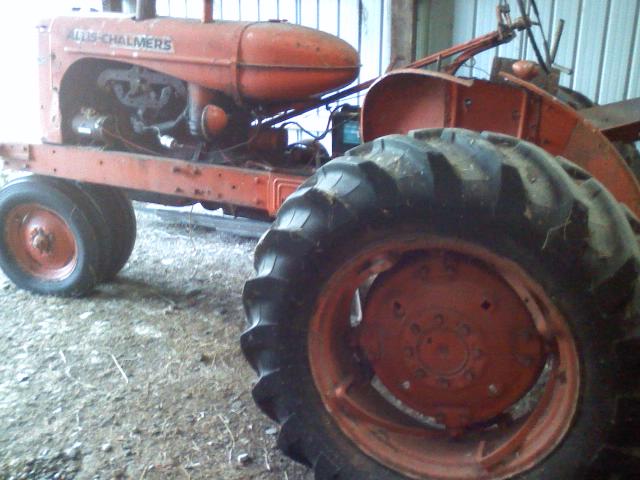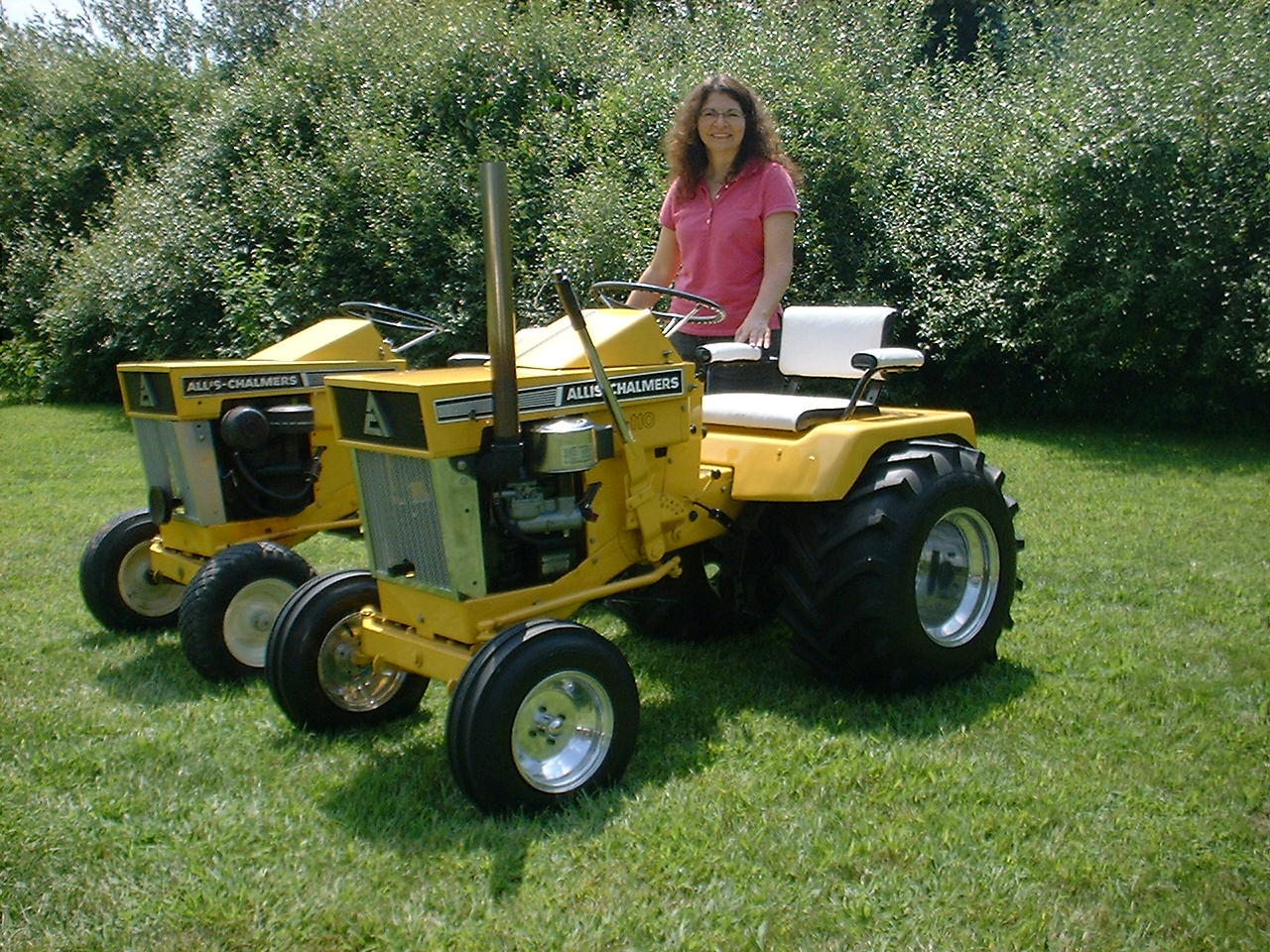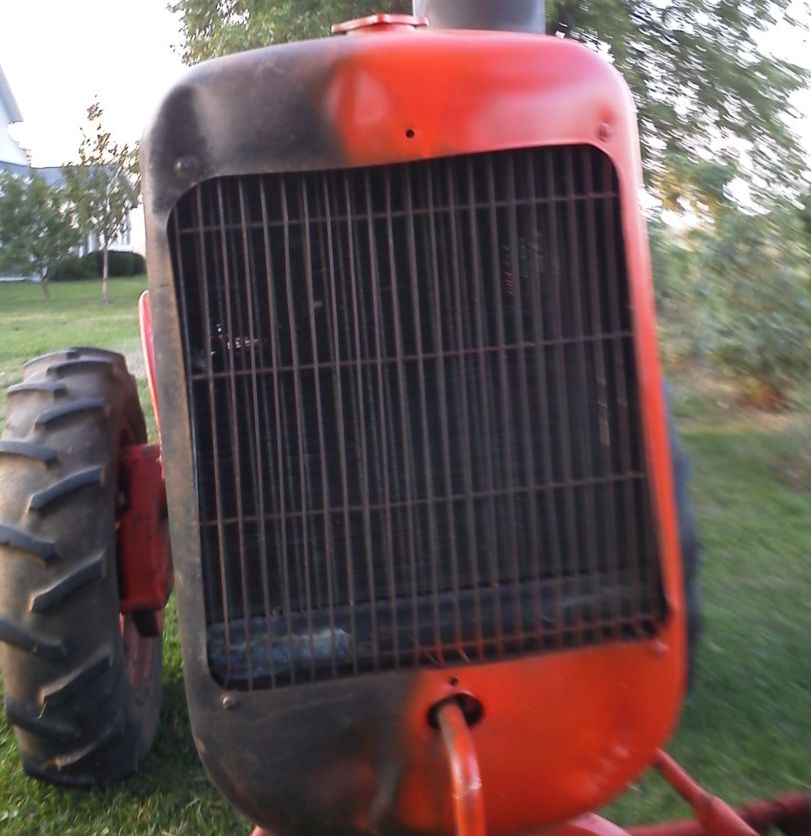| Author |
 Topic Search Topic Search  Topic Options Topic Options
|
gtorick1 
Bronze Level


Joined: 13 Sep 2014
Location: wattsburg pa.
Points: 37
|
 Post Options Post Options
 Thanks(0) Thanks(0)
 Quote Quote  Reply Reply
 Topic: is my compression to low Topic: is my compression to low
Posted: 08 Jan 2015 at 5:11pm |
|
I rebuilt my d14 motor And did a quick valve job on the head (head should be rebuilt but for now I'm trying to keep the cost down),I got it to idle with full choke but dies when I take the choke off.
I did a compression check on it and all cylinders have about 55lbs on the compression gauge, this sounds to low to me but I don't know what it should be. Is this keeping it from running off choke, I also rebuilt the Carb 3 times, cleaned the gas tank and line also,, its as clean as clean can be. All as I can figure is the compression is to low, any input would be appreciated.
|
 |
|
Sponsored Links
|
|
 |
Sugarmaker 
Orange Level


Joined: 12 Jul 2013
Location: Albion PA
Points: 8617
|
 Post Options Post Options
 Thanks(0) Thanks(0)
 Quote Quote  Reply Reply
 Posted: 08 Jan 2015 at 5:24pm Posted: 08 Jan 2015 at 5:24pm |
|
I am no way a expert, they will be here in a few minutes. What I have heard is that all cylinders should have similar compression, so you have that going for you! Not sure whether 55 is goo but you dont have one that is 10!
I just had similar engine start up issues and mine turned out to to be the bottom end of the Marvel carb. Yep I had it off 5 times at least. Called Sandy Lake and had my Allis expert Gary G look at it. I changed the carb base, which has a small jet way down at the end of the emulsion tube and the tractor is working way way better! I had to run it on half choke to keep it from faltering when trying to accelerate. No it is very responsive!
Don't give up the answer is there somewhere.
Regards,
Chris
|
|
D17 1958 (NFE), WD45 1954 (NFE), WD 1952 (NFE), WD 1950 (WFE), Allis F-40 forklift, Allis CA, Allis D14, Ford Jubilee, Many IH Cub Cadets, 32 Ford Dump, 65 Comet.
|
 |
Sugarmaker 
Orange Level


Joined: 12 Jul 2013
Location: Albion PA
Points: 8617
|
 Post Options Post Options
 Thanks(0) Thanks(0)
 Quote Quote  Reply Reply
 Posted: 08 Jan 2015 at 5:29pm Posted: 08 Jan 2015 at 5:29pm |
|
I also found one other issue. The replacement manifold had a notch cut for the nut on the carb stud. but it did not have enough clearance for the stud from the carb. This would hold the carb down off the manifold and it would suck air and run too lean. I went in with a small stone in the drill and carved out some clearance.
The other thing Sandy Lake mentioned was if the intake manifold was leaking at the head it would pull in air and run lean too.
Trying to help from afar.
Regards,
Chris
|
|
D17 1958 (NFE), WD45 1954 (NFE), WD 1952 (NFE), WD 1950 (WFE), Allis F-40 forklift, Allis CA, Allis D14, Ford Jubilee, Many IH Cub Cadets, 32 Ford Dump, 65 Comet.
|
 |
gtorick1 
Bronze Level


Joined: 13 Sep 2014
Location: wattsburg pa.
Points: 37
|
 Post Options Post Options
 Thanks(0) Thanks(0)
 Quote Quote  Reply Reply
 Posted: 08 Jan 2015 at 5:30pm Posted: 08 Jan 2015 at 5:30pm |
|
There is one small jet that I couldn't remove but it doesn't seem clogged.
I double checked for vacuum leaks, I didn't find any.
Edited by gtorick1 - 08 Jan 2015 at 5:36pm
|
 |
Sugarmaker 
Orange Level


Joined: 12 Jul 2013
Location: Albion PA
Points: 8617
|
 Post Options Post Options
 Thanks(0) Thanks(0)
 Quote Quote  Reply Reply
 Posted: 08 Jan 2015 at 5:40pm Posted: 08 Jan 2015 at 5:40pm |
|
Sorry, one more thing I even checked. I opened the drain on the bottom of the carb with engine off and let the gas flow out into a container, to make sure that the gas flow was good from the tank and through the line, through the carb. Mine checked Ok so ruled that out.
Regards,
Chris
|
|
D17 1958 (NFE), WD45 1954 (NFE), WD 1952 (NFE), WD 1950 (WFE), Allis F-40 forklift, Allis CA, Allis D14, Ford Jubilee, Many IH Cub Cadets, 32 Ford Dump, 65 Comet.
|
 |
Gerald J. 
Orange Level

Joined: 12 Sep 2009
Location: Hamilton Co, IA
Points: 5636
|
 Post Options Post Options
 Thanks(0) Thanks(0)
 Quote Quote  Reply Reply
 Posted: 08 Jan 2015 at 5:43pm Posted: 08 Jan 2015 at 5:43pm |
|
Carburetor rebuilt? Needs tuning. The shop manual settings are only close enough to get it to run enough to allow further adjustment. Idle is often an air adjustment, needs less air.The main jet needs more fuel. A leaking intake manifold gasket makes an engine run lean.
Compression is low for an engine that new. You get a low compression reading if you only pull one plug at a time. if you don't make sure the throttle and choke are full open, or the battery isn't fully charged.
With the rings dry and if new rings haven't seated compression will be low. With the plugs out squirt a half teaspoon of oil in each cylinder and spin it over a few seconds, then check compression again. The oil will make the rings seal better and if the compression (with all the other details above) isn't better, then the valves are suspect. Make sure the valves have clearance when closed.
Gerald J.
|
 |
Gerald J. 
Orange Level

Joined: 12 Sep 2009
Location: Hamilton Co, IA
Points: 5636
|
 Post Options Post Options
 Thanks(0) Thanks(0)
 Quote Quote  Reply Reply
 Posted: 08 Jan 2015 at 5:45pm Posted: 08 Jan 2015 at 5:45pm |
|
If the float level is low when the carburetor is upright the engine will also run lean.
Gerald J.
|
 |
bobkyllo 
Orange Level


Joined: 14 Sep 2009
Location: minnesota
Points: 1561
|
 Post Options Post Options
 Thanks(0) Thanks(0)
 Quote Quote  Reply Reply
 Posted: 08 Jan 2015 at 5:48pm Posted: 08 Jan 2015 at 5:48pm |
when you rebuilt the carb you turned the screws all the way in till they were snug. then backed them out one and a half turns. this will be a good starting point.
55 sure sounds weak. most are 90 to a 100. but i would think it should still run regardless
|
 |
Zaddison 
Silver Level


Joined: 19 Sep 2013
Location: Moweaqua il.
Points: 174
|
 Post Options Post Options
 Thanks(0) Thanks(0)
 Quote Quote  Reply Reply
 Posted: 08 Jan 2015 at 5:49pm Posted: 08 Jan 2015 at 5:49pm |
|
Did u re-ring the pistons if so did u put them on right. Not tryin to sound like a smart Ace but some rings only go one way. Had a buddy that had to pull his motor apart to flip the rings over cause he had no compression. I also put a farmall m head on that that had been milled to many times and when u tightened the rocker arm stands it would open the valves a little bit and had no compression.
|
 |
gtorick1 
Bronze Level


Joined: 13 Sep 2014
Location: wattsburg pa.
Points: 37
|
 Post Options Post Options
 Thanks(0) Thanks(0)
 Quote Quote  Reply Reply
 Posted: 08 Jan 2015 at 5:50pm Posted: 08 Jan 2015 at 5:50pm |
|
I will try that trick.
What's great about this and other forum web sites is that I can research all the threads that pertain to my problems so I don't have to bother the pros prematurely
|
 |
gtorick1 
Bronze Level


Joined: 13 Sep 2014
Location: wattsburg pa.
Points: 37
|
 Post Options Post Options
 Thanks(0) Thanks(0)
 Quote Quote  Reply Reply
 Posted: 08 Jan 2015 at 5:57pm Posted: 08 Jan 2015 at 5:57pm |
|
Gerald, I did the oil in the cylinder trick on a Chevy 350 once but forgot to try it on this motor, I will try that,
I did do the compression check with all the spark plugs out and a well charged 12 volt battery
And I still have to check the float level
Edited by gtorick1 - 08 Jan 2015 at 5:59pm
|
 |
mattb 
Orange Level

Joined: 11 Jan 2011
Points: 348
|
 Post Options Post Options
 Thanks(0) Thanks(0)
 Quote Quote  Reply Reply
 Posted: 09 Jan 2015 at 7:39am Posted: 09 Jan 2015 at 7:39am |
|
always do compression test withwide open throttle
|
 |
Dick L 
Orange Level


Joined: 12 Sep 2009
Location: Edon Ohio
Points: 5093
|
 Post Options Post Options
 Thanks(0) Thanks(0)
 Quote Quote  Reply Reply
 Posted: 09 Jan 2015 at 8:30am Posted: 09 Jan 2015 at 8:30am |
 mattb wrote: mattb wrote:
always do compression test withwide open throttle |
Not throwing rocks but have read this before can no understand the theory. The question I have is if you seal a can with a lid in the house how would opening a window change anything on the inside the can.
|
 |
Dick L 
Orange Level


Joined: 12 Sep 2009
Location: Edon Ohio
Points: 5093
|
 Post Options Post Options
 Thanks(0) Thanks(0)
 Quote Quote  Reply Reply
 Posted: 09 Jan 2015 at 8:44am Posted: 09 Jan 2015 at 8:44am |
|
Like Gerald said, put oil in the cylinders and take a pressure reading. If the pressure comes up the rings are the problem. If it does not come up you still have valve problems.
As stated above check gas flow out the bottom of the carburetor. If you good constant flow readjust the carburetor.
O this carburetor you want to set the idle first. The engine idle RPM's are set with the stop screw on the back. In the idle circuit fuel is drawn thru thru to the engine. The idle adjustment screw adjusts for the proper amount of air to make the engine run smooth at your desired idle RPM. After the engine is running above idle you make small adjustments to as you bring the throttle lever back to the idle position. After the idle is set with choke off and lever back you then move the throttle lever to wide open. you then adjust the power jet to cause the engine to run at the highest RPM. You then turn in the power jet in until you notice a slight lower RPM. This will be the best you will get with out having the tractor under load which is not necessary unless you are going to tax the engine power.
Make sure you have the .012 clearance under the rocker arms.
|
 |
Steve in NJ 
Orange Level Access


Joined: 12 Sep 2009
Location: Andover, NJ
Points: 12032
|
 Post Options Post Options
 Thanks(0) Thanks(0)
 Quote Quote  Reply Reply
 Posted: 09 Jan 2015 at 8:46am Posted: 09 Jan 2015 at 8:46am |
|
Okay, so you mentioned you did have it running, but it would only idle but with the choke on. Well, to me, the compression sounds low, but you only did a dry test is what it sounds like. I would do the wet test and see what the compression is then. If the compression comes up quite a bit, I would think providing things are assembled correctly, that the compression is low due to the rings not seating totally yet because of the little run time. ASSUMING everything downstairs is okay, running with the choke closed indicates a lean condition whether it be low floats or not enough fuel, or a plugged enrichment circuit. Its important that the enrichment circuit as well as the vent port is clean. I would start at the tank and do my fuel delivery checks of fuel flow, to the carb. If that looks good after a few minutes of fuel running into a clean catch can, move to the inside, check float level, look for any debris, etc. Keep moving along. You'll find the problem. Also, you just put the engine back together. As Chris mentioned, check to make sure the intake is seated flush onto the head. If the engine idles rough, spray a little carb cleaner around the intake while its idling. If the engine rpms jump up and the engine smooths out for a second or so, you have a vacuum leak. Also, check valve lash. Valves that are to tight will sometimes give you the same kinda problem like its not getting fuel. HTH
Steve@B&B
|
|
39'RC, 43'WC, 48'B, 49'G, 50'WF, 65 Big 10, 67'B-110, 75'716H, 2-620's, & a Motorhead wife
|
 |
Gerald J. 
Orange Level

Joined: 12 Sep 2009
Location: Hamilton Co, IA
Points: 5636
|
 Post Options Post Options
 Thanks(0) Thanks(0)
 Quote Quote  Reply Reply
 Posted: 09 Jan 2015 at 9:49am Posted: 09 Jan 2015 at 9:49am |
|
The measured compression depends on the volume of air taken into the cylinder on the intake stroke. Any restrictions (air cleaner, choke, throttle) limit the flow on the intake stroke and so limits the pressure at the top of the compression stroke. If the cylinder drew a perfect vacuum of -15 psi and it only filled half way to -7.5 psi, on compression it won't make anywhere near the rated pressure.
Then when the shop manual lists a compression pressure the most consistent measuring condition is with choke and throttle full open. Choke and throttle partly closed is not a reproducible condition.
I've never seen an engine make the compression pressure on the first compression stroke, it takes a few strokes and how many is also an indication of engine condition.
When tuning a carburetor, the idle and main jet adjustments interact so it takes more than one refinement on each to get tuned right. Start with idle, then high speed/power, then idle, then high speed and repeat until neither changes. The governor will hide the effects of tuning so it has to be overridden or observed that as tuning improves it closes the throttle. Idle tuning is most effective with the throttle plate closed as much as possible by backing off the idle speed screw on the throttle shaft quadrant. That's because when the throttle plate is tightly closed the only fuel comes from the idle circuit and as the throttle plate is opened even slightly some fuel comes from the high speed jet and circuit.
Gerald J.
|
 |
gtorick1 
Bronze Level


Joined: 13 Sep 2014
Location: wattsburg pa.
Points: 37
|
 Post Options Post Options
 Thanks(0) Thanks(0)
 Quote Quote  Reply Reply
 Posted: 10 Jan 2015 at 4:35pm Posted: 10 Jan 2015 at 4:35pm |
|
Update, I disassembled and cleaned the Carb for the 4th time, this time I adjusted the float and played with the fuel adjustments, and I got it to idle with the choke off, I had to quit there because the garage was filling with exhaust and its too cold to get it outside to fine tune it. Once I know its not a gear jumper,i will rebuild the head I hope that will help with the low compression issue, Thanks all for your help.
|
 |
DaveKamp 
Orange Level Access


Joined: 12 Apr 2010
Location: LeClaire, Ia
Points: 6102
|
 Post Options Post Options
 Thanks(0) Thanks(0)
 Quote Quote  Reply Reply
 Posted: 11 Jan 2015 at 12:01pm Posted: 11 Jan 2015 at 12:01pm |
 Dick L wrote: Dick L wrote:
 mattb wrote: mattb wrote:
always do compression test withwide open throttle |
Not throwing rocks but have read this before can no understand the theory. The question I have is if you seal a can with a lid in the house how would opening a window change anything on the inside the can.
|
Or an easier way to put it: When you measure pressure with a compression tester, you're essentially doing what a tire gauge does to a tire... it compares pressure inside the tire, against pressure OUTSIDE the tire. It's not actually measuring absolute pressure, it's comparing it against atmospheric pressure. Let's say you take a pressure reading of a sealed vessel at sea level... and the indicated pressure is 15psi. At 10,000 feet, you should still have 15psi, right? Not if the gauge you're reading, is comparing ambient pressure against the vessel... it will indicate HIGHER, because ambient pressure at 10,000 feet is much lower. The difference of having a closed throttle is twofold: First, it causes the engine to become a vacuum pump... it is REDUCING the ambient pressure being drawn into the cylinder. That means that the relative pressure you're measuring at the gauge, will be substantially skewed... it will read dramatically lower. A simple (but dangerous) demonstration, would be to cap off the intake of your shop air compressor and see how much it's output is affected. Second, the throttle is not a 'consistent' device in terms of applying drag... it rattles around... so the readings you'll get, will be rather unrepeating. Hence, the standard is to hold throttle full open when doing a compression test. 
|
|
Ten Amendments, Ten Commandments, and one Golden Rule solve most every problem. Citrus hand-cleaner with Pumice does the rest.
|
 |
DrAllis 
Orange Level Access

Joined: 12 Sep 2009
Points: 22285
|
 Post Options Post Options
 Thanks(0) Thanks(0)
 Quote Quote  Reply Reply
 Posted: 11 Jan 2015 at 12:16pm Posted: 11 Jan 2015 at 12:16pm |
|
A D-14 with only 55 psi of compression on every cylinder is either being tested with a defective compression tester or, the throttle is completely idled down/butterfly shut.
|
 |









 Topic Options
Topic Options

 Post Options
Post Options Thanks(0)
Thanks(0)






 mattb wrote:
mattb wrote:


